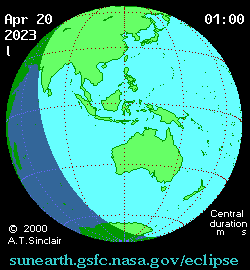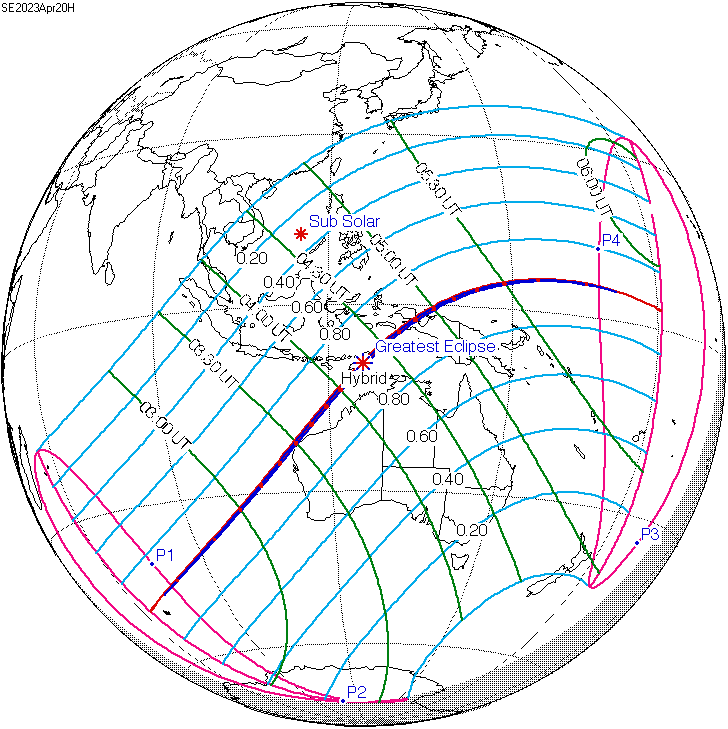This Thursday a hybrid eclipse will occur over parts of Australia, East Timor, and occupied West Papua. Mostly, however, it will be over ocean. It’s the first hybrid eclipse since 2013. As always with solar eclipses, people over a much larger area, in this case Australia and South-East Asia, will experience the dimming of a partial eclipse, and this one could be particularly worth viewing if skies are clear.
What is a hybrid eclipse?
The existence of a hybrid eclipses depends on a curious fact: the Sun and Moon take up almost exactly the same area of the sky. It wasn’t always like this – the Moon is getting steadily further away so it looked larger quite recently, and soon it will be noticeably smaller. Moreover, the Moon’s orbit is not perfectly circular, which affects its apparent size, giving us so-called “supermoons” when the Moon happens to be full near the closest part of its orbit.
When closer, the Moon is large enough to create a total solar eclipse if it passes directly between a part of the Earth and the Sun. However, when the three bodies line up perfectly, but the Moon is further from us, it creates an annular eclipse, where a ring of the actual Sun (not just the corona) can briefly be seen encircling the Moon. The solar eclipse crossing parts of North and South America later this year will be annular, while next year’s North American event will be total.
A hybrid eclipse occurs when the Moon is close enough to produce a total eclipse over the nearest parts of the Earth, but when the eclipse path reaches areas made more distant by the curve of the Earth it becomes annular (Flat Earthers might want to think about this for a moment).
For this to happen the timing needs to be near-perfect, at the point of the Moon’s orbit where its full shadow reaches the nearest part of Earth, but only just.
Put like this, the amazing thing is not that hybrid eclipses happen only every decade or so, but that they are not a once-in-a-millennium thing. Nevertheless, this is the third of this century, and in 1986/87 two happened within six months.
Just because an eclipse is hybrid doesn’t mean most viewers will get to see both total and annular states. Solar eclipses occur over long, narrow stretches of the planet and for most of that distance the eclipse is either one thing or another. To see both you’d need to be in an aircraft racing with the Moon’s shadow.
On either side of this path observers see only a partial eclipse – it makes no difference to them whether they are nearer the total or annular part.
Thursday’s eclipse

The path of the partial eclipse. Image credit: A.T. Sinclair/NASA
The April 20 eclipse appears to have gone out of its way to make it hard for observers to see it. The line of totality touches Australia’s coast at the Exmouth Peninsula and passes over Barrow Island. Both are far from major population centers and could handle only a small number of tourists, even before last week’s major cyclone. From there it bends away from Indonesia’s more populated islands, passing over East Timor and West Papua before heading out to the Pacific.
Some people undeterred by the COVID experience will be watching it from cruise ships off the Australian coast.
For most of its path, including all the parts over land, the eclipse is total, only becoming annular at its very beginning and end in the southern and mid-Pacific Oceans, respectively.
On the plus side, hundreds of millions of people will get to see a partial eclipse if they have the right equipment, but outside Indonesia for most of them it will be very partial indeed. From Melbourne and Sydney around 20 percent will be obscured at maximum, and a thin sliver of south-eastern China will witness just a small percentage of the Sun being hidden.

The curving path of the eclipse looks like it was designed to avoid land, particularly heavily populated land. Image credit: Fred Espenak, NASA’s GSFC
Paltry as these are, there is some compensation. The Sun is currently so active there are likely to be abundant sunspots visible on the non-obscured parts of the Sun.
Never look directly at the Sun, particularly during an eclipse, unless wearing eclipse glasses from a reputable source. If using a telescope or binoculars, either project the Sun’s image onto a blank surface or use high quality shielding material over the front, never the back, of the instrument.
For those not in the right location, lacking suitable equipment, or simply thwarted by cloud, the event will be streamed live by Time and Date and in conjunction with the Perth Observatory.
Source Link: What Is A Hybrid Eclipse, The Once-In-A-Decade Event Happening This Week?